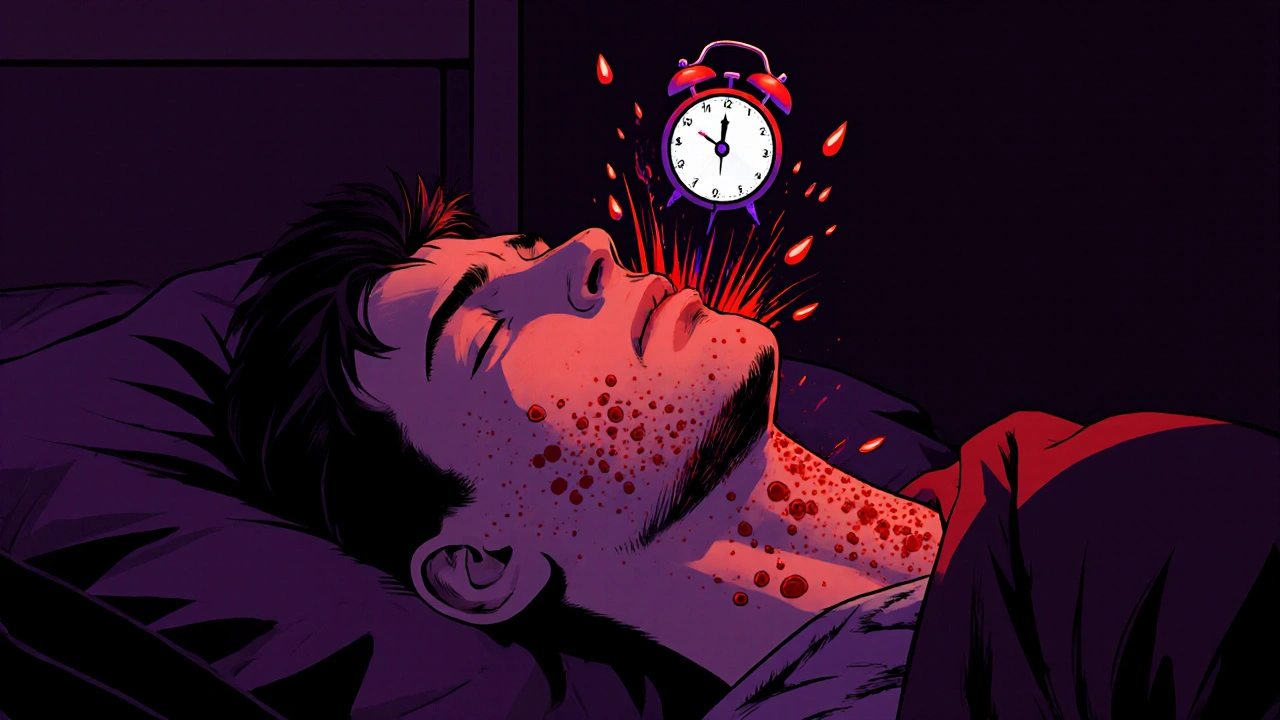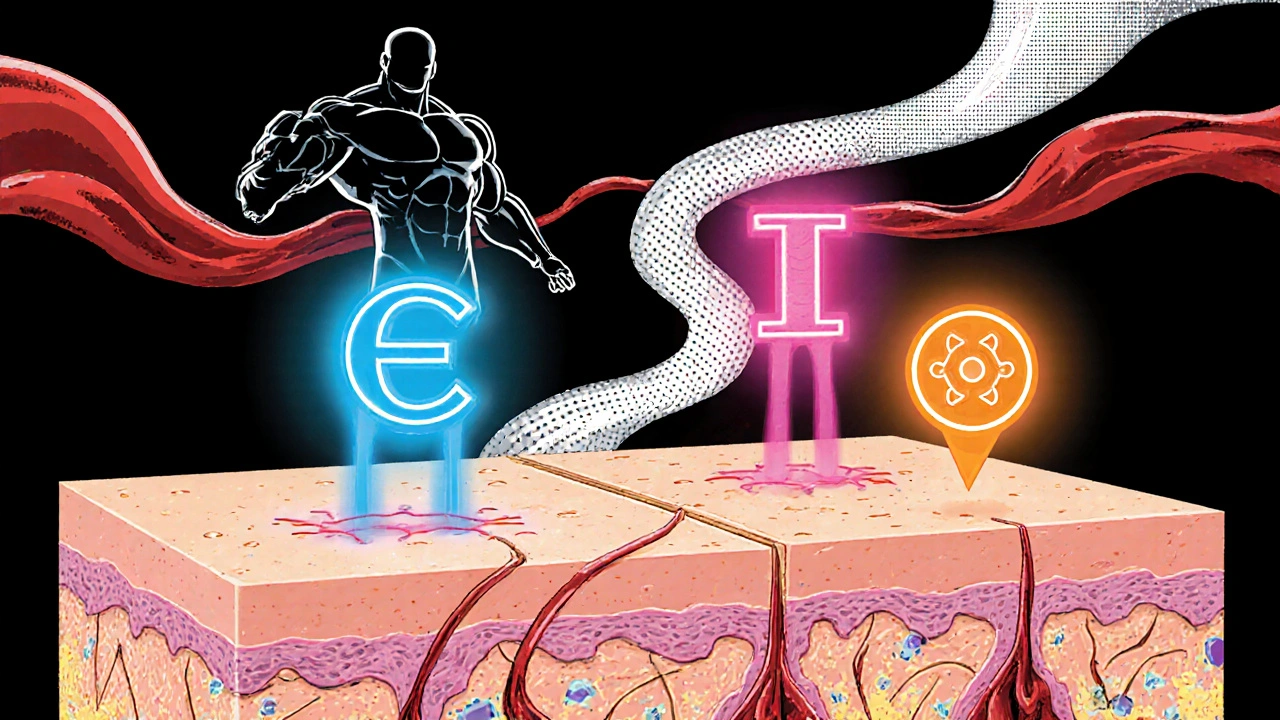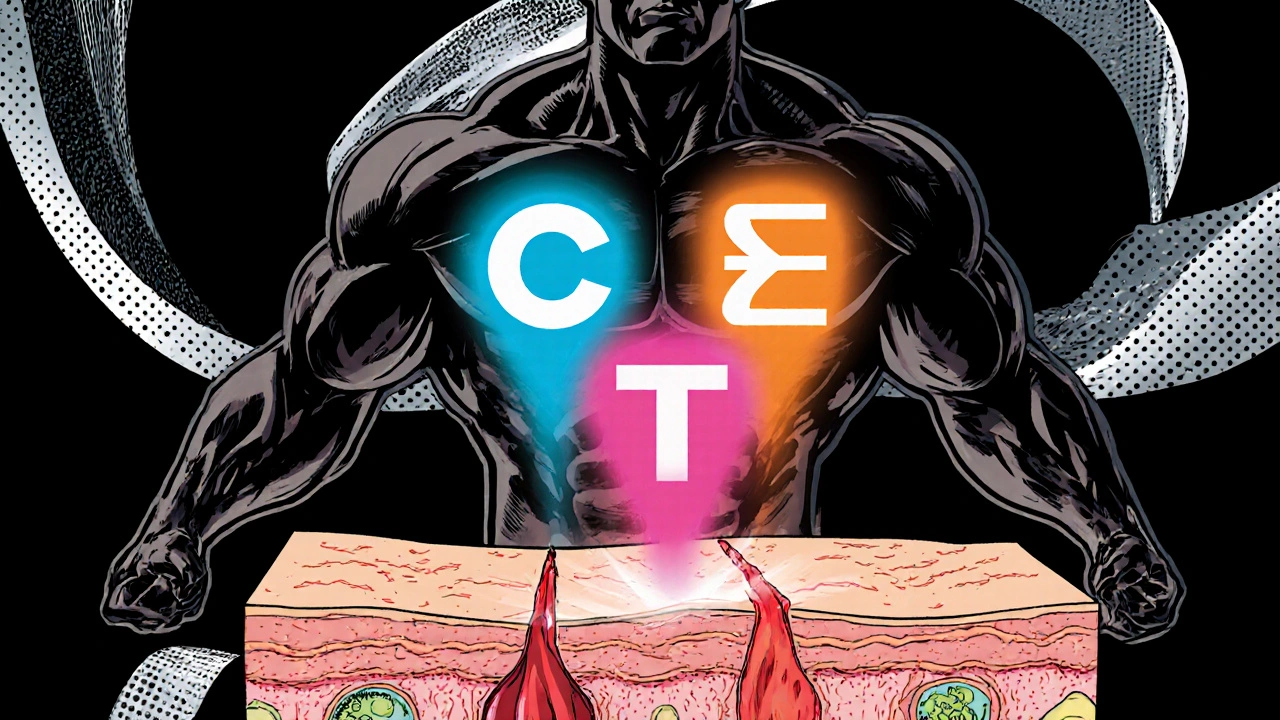Hormonal Skin Inflammation Assessment Tool
Diagnose Your Skin Inflammation Trigger
Select your symptoms and lifestyle factors to identify which hormone is likely contributing most to your skin issues.
Your Hormonal Trigger Analysis
Personalized Recommendations
When it comes to skin health, Hormones are chemical messengers produced by endocrine glands that travel through the bloodstream to regulate organs, tissues, and bodily functions play a central role. Their fluctuations can ignite or calm the skin’s inflammatory response, leading to everything from occasional redness to persistent breakouts.
What Is Skin Inflammation?
Skin inflammation is the body's immune reaction that causes redness, swelling, heat, and sometimes pain in the epidermis and dermis. While a short‑term flare helps fend off infection, chronic inflammation often manifests as acne, rosacea, eczema, or even premature aging.
How Hormones Influence the Inflammatory Process
Hormones interact with skin cells in three key ways:
- Modulating sebum production - oily skin creates a perfect breeding ground for bacteria that trigger inflammation.
- Altering the immune response by influencing white‑blood‑cell activity and cytokine release, which determines how aggressively the skin reacts to irritants.
- Changing the barrier function - hormones can thin or thicken the outermost layer, affecting moisture retention and susceptibility to external triggers.
When any of these pathways go haywire, the result is a visible flare. Below we break down the three hormones most often blamed for skin drama.
Cortisol: The Stress Hormone
Cortisol is a glucocorticoid released by the adrenal glands in response to stress. Elevated cortisol does three things to the skin:
- Boosts oil‑gate (sebaceous) activity, leading to excess sebum.
- Suppresses the skin’s natural barrier, making it easier for irritants to penetrate.
- Triggers the release of pro‑inflammatory cytokines such as IL‑6 and TNF‑α, which amplify redness and swelling.
Real‑world cue: a night of poor sleep followed by a hormonal surge often ends with a “stress breakout” of papules and pustules on the jawline.

Estrogen: The Female Hormone
Estrogen is the primary female sex hormone produced in the ovaries, placenta, and in smaller amounts by adrenal tissue. Its influence on skin inflammation is nuanced:
- During the high‑estrogen phase of the menstrual cycle, collagen synthesis ramps up, often improving skin texture.
- However, estrogen can also increase the expression of certain inflammatory markers, especially when it spikes abruptly during pregnancy or hormone therapy.
- Post‑menopausal drops in estrogen often coincide with dry, itchy skin and a higher incidence of eczema.
Noticeable pattern: many women report worsening rosacea symptoms during perimenopause when estrogen levels fluctuate wildly.
Testosterone: The Androgen Powerhouse
Testosterone is an androgen produced primarily in the testes, ovaries, and adrenal glands that drives the development of male characteristics. Its direct impact on skin includes:
- Stimulating sebaceous glands to produce more oil, a classic trigger for acne.
- Increasing the thickness of the epidermis, which can mask underlying inflammation until it erupts as deep, cystic lesions.
- Elevated levels during puberty or with anabolic steroid use often result in severe, recurring breakouts.
Practical tip: men who notice a sudden flare after a period of intense weight training may be experiencing a testosterone‑driven surge.
Other Players that Bridge Hormones and Inflammation
Beyond the three headline hormones, several supporting factors fine‑tune the skin’s response:
- Sebum Production the process by which oil is secreted from sebaceous glands - directly linked to cortisol and testosterone.
- Cytokines signaling proteins like IL‑1, IL‑6, and TNF‑α that orchestrate inflammation - heightened by hormonal spikes.
- Immune Response the activity of skin‑resident immune cells such as Langerhans cells and mast cells - modulated by estrogen and cortisol.
Lifestyle Factors that Amplify Hormonal Flare‑Ups
Even if your hormones are within normal ranges, certain habits can push them into a reactive zone:
- Sleep deprivation - spikes cortisol, reduces skin‑repair hormones like growth hormone.
- High‑glycemic diet - causes insulin spikes that indirectly raise androgen activity.
- Excessive alcohol - impairs liver detox pathways, leading to hormone imbalance.
- Chronic stress - sustains cortisol elevation, prolonging inflammation.
Adjusting these variables often yields a noticeable calming of the skin within a few weeks.
Managing Hormone‑Driven Skin Inflammation
Below is a step‑by‑step playbook you can follow:
- Identify the hormonal culprit - keep a symptom diary aligned with menstrual cycles, stress peaks, or medication changes.
- Consult a dermatologist or endocrinologist for lab tests if patterns suggest a medical imbalance.
- Optimize sleep: aim for 7‑9 hours, use blue‑light filters, and maintain a consistent bedtime.
- Balance blood sugar: choose low‑glycemic carbs, incorporate protein and healthy fats at each meal.
- Introduce topical anti‑inflammatories such as niacinamide or low‑dose azelaic acid to calm cytokine overdrive.
- Consider oral interventions only under professional guidance - e.g., low‑dose oral contraceptives for estrogen regulation, or adaptogenic herbs for cortisol moderation.
- Maintain skin barrier: use ceramide‑rich moisturizers to offset hormone‑induced barrier loss.
Consistent application of these steps can reduce flare frequency by 30‑50% for most people.

Quick Reference Cheat Sheet
| Hormone | Effect on Sebum | Cytokine Influence | Typical Skin Issue |
|---|---|---|---|
| Cortisol | ↑ Oil production | ↑ IL‑6, TNF‑α | Stress‑related acne, eczema flare |
| Estrogen | ↔ Moderate | Variable; can ↑ inflammatory markers during rapid shifts | Rosacea, perimenopausal eczema |
| Testosterone | ↑ Sebum | ↑ IL‑1β | Acne (especially cystic), oily skin |
Key Takeaways
- Hormones act as master switches that can turn skin inflammation up or down.
- Cortisol, estrogen, and testosterone are the top three drivers of flare‑ups.
- Lifestyle tweaks that stabilize hormone levels often provide the fastest skin relief.
- When DIY methods fall short, professional testing and targeted therapy are essential.
Frequently Asked Questions
Can stress really cause acne?
Yes. Stress raises cortisol, which boosts oil production and releases pro‑inflammatory cytokines. The combo creates a perfect environment for acne‑causing bacteria.
Why does my skin get worse during my period?
Hormonal fluctuations-especially a dip in estrogen and a relative rise in progesterone-can increase sebum and trigger inflammation, leading to breakouts around the chin and jawline.
Is there a diet that helps balance hormonal skin issues?
Low‑glycemic foods, plenty of omega‑3 fatty acids, and consistent protein intake help steady insulin and androgen levels, which can calm acne and reduce redness.
Should I take hormone supplements for better skin?
Only under medical supervision. Supplements can quickly tip the balance and may worsen inflammation if not properly matched to your hormonal profile.
What topical ingredients calm hormone‑induced inflammation?
Niacinamide, zinc PCA, and low‑dose azelaic acid are proven to reduce cytokine activity and tighten the skin barrier without disrupting hormones.


Comments (17)
Grover Walters
15 Oct, 2025One might regard hormones as unseen conductors orchestrating the skin’s inflammatory symphony. When cortisol spikes, it cues sebaceous glands to overproduce oil, setting the stage for bacterial overgrowth. Conversely, a dip in estrogen can diminish barrier integrity, allowing irritants to breach. Testosterone, by thickening the epidermal layer, often masks the brewing storm until a cyst erupts. Thus, the hormonal milieu functions as a master switch toggling dermal homeostasis.
Amy Collins
19 Oct, 2025Honestly, the piece dives deep into sebaceous hyperactivity, but it feels like a textbook marathon. All that talk about cytokine cascades could be trimmed to a quick TL;DR. Still, the list of lifestyle triggers hits the nail on the head – sleep debt, high‑glycemic munchies, and booze are the usual suspects. It’s a solid primer, albeit a bit wordy.
amanda luize
22 Oct, 2025The article presents a veneer of scientific neutrality while subtly advancing a pharmaceutical agenda. Notice how the list of oral interventions is limited to prescription‑only compounds, ignoring affordable nutraceutical alternatives. This selective citation suggests a bias toward industry‑sponsored studies. Moreover, the omission of long‑term data on adaptogenic herbs raises red flags. One must question who funds the research that informs such recommendations. Vigilance is essential when the discourse is curated by vested interests.
Rafael Lopez
25 Oct, 2025Optimizing sleep is arguably the most potent, non‑pharmacologic tool for stabilizing cortisol levels, and you should aim for 7–9 hours of uninterrupted rest, protect your bedroom from blue‑light exposure, and establish a consistent bedtime routine; additionally, mindfulness practices such as meditation can further blunt stress‑induced hormonal spikes, while maintaining a cool, dark sleeping environment supports melatonin production, which in turn aids skin repair.
Craig Mascarenhas
29 Oct, 2025These so called 'lifestyle hacks' are really a distraction from the bigger picture. Big Pharma wants us to think we need costly creams while they sell secret hormone modulators. If you look at the data you’ll see a pattern of omitted side effects. Trust the natural barrier and keep your diet simple. Don’t be fooled.
aarsha jayan
1 Nov, 2025Your caution is understandable, and it’s wise to question where information originates. Yet many simple dietary tweaks and consistent sleep can genuinely improve barrier function without any hidden agenda. Think of these steps as empowering choices rather than a corporate ploy. Keep experimenting and share what works for you.
Rita Joseph
5 Nov, 2025Sleep hygiene indeed plays a central role, and the recommendations you listed are spot‑on. I’d add that limiting caffeine after noon can prevent cortisol spikes later in the evening. Also, incorporating a short stretch routine before bed helps lower sympathetic tone. Pairing these habits with a gentle, ceramide‑rich moisturizer can further support barrier recovery. Consistency over time yields the best results.
Arlene January
8 Nov, 2025Yo, I feel ya on the info overload – the article is a beast! But those hormone basics are actually pretty useful once you break ’em down. Shortening the list to the top three culprits helped me spot my own triggers. Keep it simple and you’ll see fewer flare‑ups.
Kaitlyn Duran
12 Nov, 2025I love how you distilled the complex stuff into bite‑size nuggets; it makes tracking patterns way easier. When I logged my stress levels alongside my skin diary, the correlation was crystal clear. It’s amazing what a few minutes of reflection each day can reveal. Stay curious and the skin will thank you.
Earlene Kalman
15 Nov, 2025The piece definitely pushes pharma products while downplaying cheaper options. It reads like a subtle advertisement rather than unbiased advice. That’s a red flag for anyone looking for truly independent guidance.
Sherine Mary
19 Nov, 2025While I see your point about potential bias, not every mention of prescription therapy stems from sponsorship. Some clinicians rely on evidence‑based medicines that truly outperform over‑the‑counter alternatives. Still, transparency about funding sources would strengthen credibility. Readers deserve full disclosure.
Lily Saeli
22 Nov, 2025Truth, in its purest form, should never be shrouded behind profit motives. When knowledge is sold, the vulnerable become commodities. We must guard the sanctity of health information as a moral imperative. Let us champion open, peer‑reviewed data accessible to all. Only then can we claim ethical integrity.
Meg Mackenzie
26 Nov, 2025The "empowering choices" narrative sounds nice, but it conveniently glosses over how stress hormones are manipulated by modern work culture. We’re wired to respond to constant notifications, which keeps cortisol perpetually elevated. Even the healthiest diet can’t fully counteract that relentless pressure. Acknowledging the systemic issue is the first step toward real change. Don’t settle for surface‑level fixes while the underlying engine keeps revving. Awareness, not just individual tweaks, matters.
Shivaraj Karigoudar
29 Nov, 2025When it comes to repairing the skin barrier, the interplay between sleep, nutrition, and topical care forms a delicate triangle that cannot be ignored.
First, achieving consistent, high‑quality sleep allows the body to enter deep restorative phases where growth hormone peaks and cortisol recedes.
During these nocturnal windows, keratinocytes proliferate, collagen synthesis accelerates, and the epidermal turnover rate normalizes, all of which are essential for a resilient barrier.
Second, nutrition supplies the raw materials-essential fatty acids, antioxidants, and vitamins-that fortify lipid bilayers and neutralize reactive oxygen species.
A diet rich in omega‑3 fish oil, bright‑colored fruits, and lean protein provides the phospholipids and polyphenols needed to patch microscopic gaps.
Third, the topical regimen should focus on barrier‑restoring actives such as ceramides, niacinamide, and hyaluronic acid, applied while the skin is still slightly damp to maximize absorption.
Layering these ingredients in the correct order-serum first, moisturizer second-prevents occlusion and ensures each molecule reaches its target.
Moreover, avoiding harsh surfactants and over‑exfoliation protects the acid mantle, which is the skin’s first line of defense against pathogenic invasion.
In practice, a simple routine might consist of a gentle cleanser, a niacinamide serum, a ceramide‑enriched cream, and a sunscreen with zinc oxide during daylight hours.
Applying sunscreen is non‑negotiable because UV radiation not only accelerates photoaging but also disrupts hormonal signaling pathways that regulate sebum production.
Consistency is the keystone; intermittent adherence yields only sporadic improvements, whereas daily commitment compounds benefits over weeks and months.
Tracking progress with a weekly photo log and noting any flare triggers can help fine‑tune the approach, allowing for data‑driven adjustments.
If after a month you observe minimal change, consider consulting a dermatologist to rule out underlying endocrine disorders that may require targeted therapy.
Remember that lifestyle factors such as chronic stress and irregular sleep can quickly undermine even the most meticulously crafted skincare protocol.
Therefore, integrating stress‑reduction techniques like meditation, breathwork, or moderate exercise amplifies the restorative effects of sleep and nutrition.
In summary, a holistic strategy that synchronizes restorative sleep, balanced nutrition, and barrier‑supportive topicals offers the most sustainable path to calmer, healthier skin.
Matt Miller
3 Dec, 2025Consistency over time really does the trick.
Fabio Max
6 Dec, 2025Great point! Building those small habits feels doable, and the positive feedback loop keeps motivation high. Stay patient and celebrate each improvement-your skin will thank you.
Darrell Wardsteele
10 Dec, 2025The initial statement is well‑crafted; however, note that “orchestrating” should be followed by a comma when introducing a dependent clause, and “dermal” needs a hyphen when paired with “homeostasis‑related” for clarity.